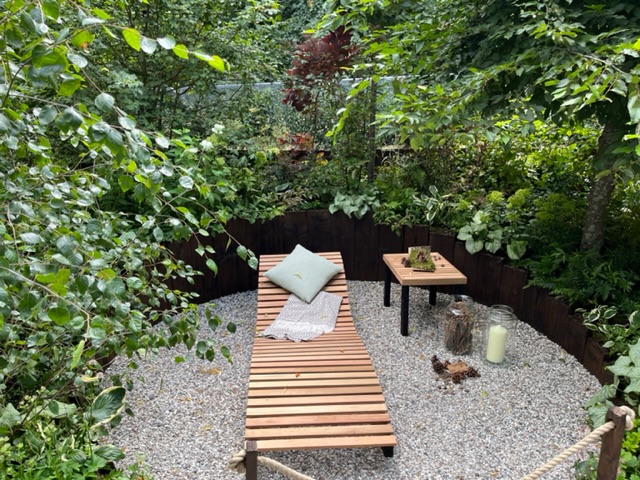Turn your garden into a soothing, sensory sanctuary
If you have a garden, you can make some simple changes and soak up all the benefits of Forest Bathing, even without the forest. Forest Bathing is a mindfulness practice that involves spending time under the canopy of trees, surrounded by nature to improve health and wellbeing. Read more about Forest Bathing.
We are all now aware of the scientific evidence showing how nature can be a powerful antidote to the stresses of modern life. Gardening is proven to reduce stress levels and expose us to immune-boosting microbes in the soil and in Japan Forest Bathing has been evaluated as an effective mental health therapy that can alleviate short-term mood disturbance. It is also recommended as a treatment for anxiety, depression and addiction as well as other mental illnesses. Read more about the benefits of Forest Bathing.
So why not merge the two? Let’s give our gardens a Forest Bathing makeover and create a mindful space to feed your soul. Taking inspiration from the 2022 RHS Hampton Court Palace Forest Bathing Garden by award-winning garden designer Dave Green, here are my top tips to create your horticultural haven.
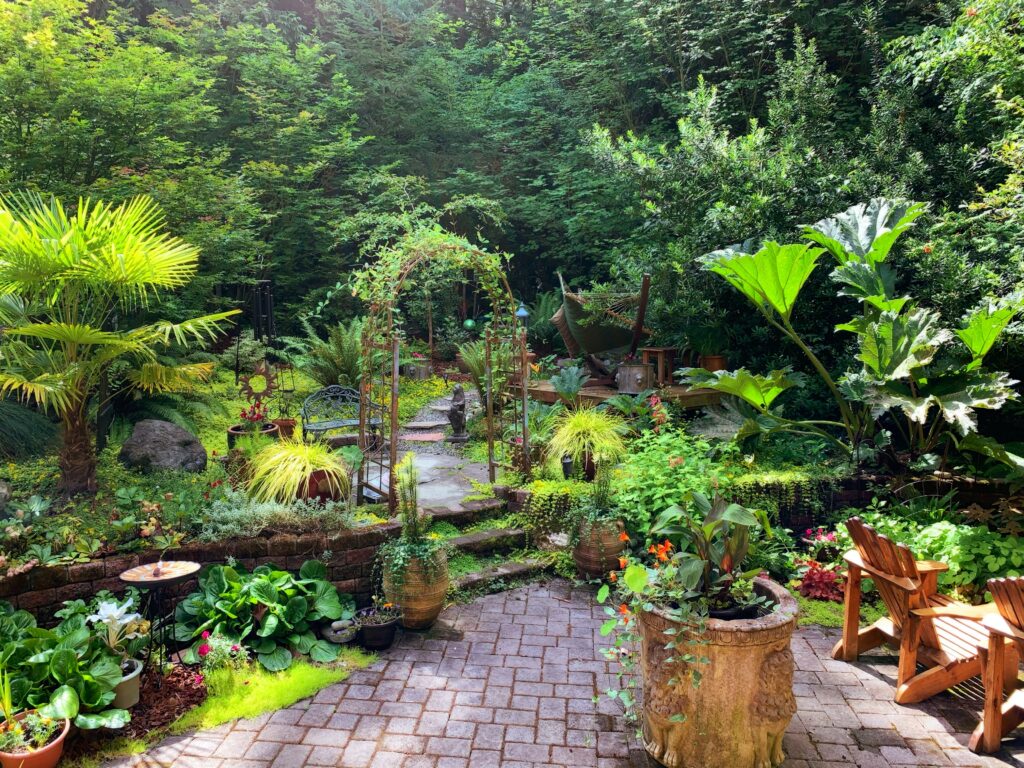
How to create your nourishing Forest Bathing garden
It doesn’t matter if your garden is teeny, because you can create a green space for mindfulness in a much smaller setting than a forest. All the tips and ideas here are designed to help you explore your surroundings with your senses (instead of the analytical, logical brain). Mindful Forest Bathing exercises, known as ‘invitations’, include activities like noticing colours, patterns and perception, listening to sounds, appreciating textures through touching bark and leaves, and smelling leaf litter and moss.
You want to create a garden that makes it easy for you to undertake these types of gentle, sensory activities. There is no right or wrong, and you can walk, sit or lie down when Forest Bathing.
1 – Go glorious green
Green is everywhere and in countless shades in nature, especially in the forest. The human eye sees green better than any colour in the spectrum and colour experts claim it’s the most relaxing colour for the human eye to view. It’s associated with renewal, growth and hope and is also thought to help healing by relieving stress, nervousness, and depression. So, plant a palette of green hues, including lots of lush, rich and bold shades evoking feelings of abundance and security.
Where possible, recreate the variety of the woodland with trees to provide a shady green canopy, bushes and shrubs for eye-level interest and a mixture of green ground cover.
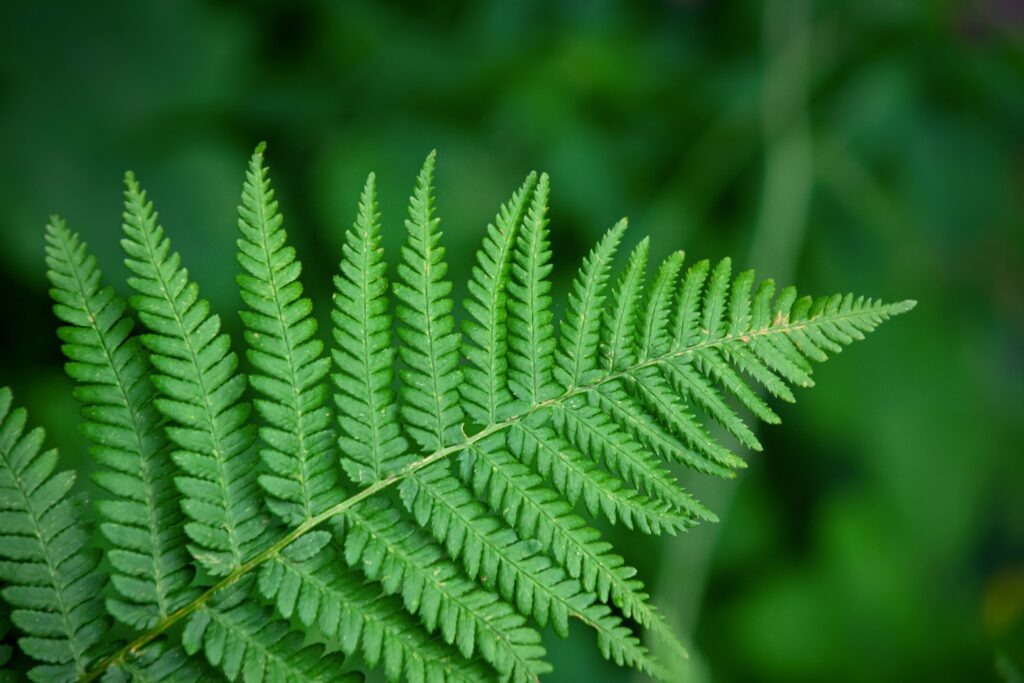
2 – Heighten your senses in your Forest Bathing garden
Sights
Try to include a variety of plants with contrasting leaf shapes, patterns and appearances. Ferns are a classic (and prehistoric!) woodland plant and a great example of a fractal – a repetition of patterns at smaller and smaller scales. Exposure to fractal patterns in nature can significantly reduce your stress levels, seemingly because of a physiological resonance within the eye. Other examples of fractals are snowflakes, tree branches and lightning.
Athyriumniponicum Ursula Red is a dramatic and deciduous fern with arching triangular leaves marked deep purple at the base and along the stem accompanied by striking silver-white tipped pinnules. Dryopteris wallichiana Jurassic Gold Alpine Wood Fern has eye-catching golden orange fronds, but as they mature and become more spreading, their colour changes to light green.
Smells
Often in my Forest Bathing sessions, the aromas of the forest evoke happy memories and feelings of childhood freedom. So, include a variety of seasonal scents in your planting, I’d recommend including at least one rose, and ensure an abundance of leaf litter and moss to further create a sense of place.

Sounds
One of our favourite things in nature is the sound of the rustling leaves or wind in the trees. There’s even an obsolete English word for this sound – psithurism. ‘Said with a ‘silent p’, it’s a fine sounding word with wonderful meaning (and almost onomatopoeic), I think we should petition for its reintroduction!
Including birch is a great way to achieve this as the leaves are magnificent rustlers. You could also hang strings of chimes to catch the breeze or even add a water feature.
Touch
Positioning grasses next to paths or seating areas offers the chance to stroke their tactile foliage while also enjoying the soothing rustling sounds they make as you brush past. The evergreen perennial Anemanthele lessoniana Pheasant’s tail grass, provides year-round colour and structure with bold, low clumps of light-reflecting leaves. Its foliage emerges green, maturing to yellow, orange and red over time, reaching a peak in intensity in winter.
Another great grass is Imperata cylindrica ‘Red Baron’ Blood grass with its striking leaves topped with blood-red, the colouring developing on the tips and spreading down the green stem.
It’s almost impossible not to lose track of time exploring tree bark, in particular birch bark, and give your feet a treat by planting a spot of Scleranthus Biflorus Irish Moss and making barefoot walking a regular part of your self-care regime.
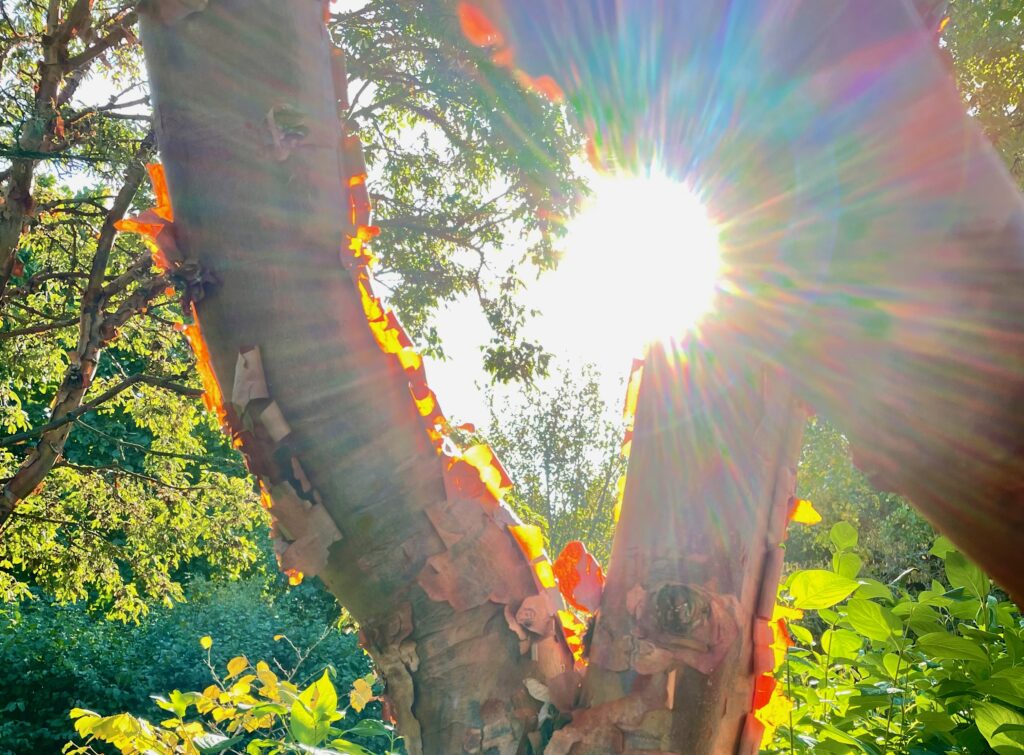
3 – Embrace seasonal interest
Consider planting to provide interest throughout the year, since forest bathing happens in all seasons. Remember, there’s no such thing as bad weather, just bad clothing 😃
Here are six ideas for you to consider:
- Cornus sanguina Common Dogwood will really brighten up the garden during those cold, grey days. Cloaked in green foliage throughout summer, by autumn the foliage turns to a fiery shade of red. It then falls to the ground to reveal spectacular orange, yellow and red stems.
- Carpinus betulus Hornbeam is one of the earliest trees to come into leaf in spring with its striking lime green crinkled foliage. These leaves become bronze in autumn and are then held on the tree through winter.
- Coronillas are shrubs with lush green foliage that embrace clusters of round-headed blooms from November to March. During spells of warmer sunshine, a sweet fragrance will disperse from these blooms to remind you of warm spring days.
- Bring a touch of magic to your garden with the luxuriant blousy blooms and abundant evergreen foliage of Hellebores.
- The vibrant, waxy berries of Holly contrast beautifully with the evergreen leaves, the ultimate festive colour combination. Perfect for cutting too, so you can decorate your home with the sprigs.
- Edgeworthia’s silky buds adorn its bare branches in winter, before bursting open to create clusters of deliciously scented blooms.
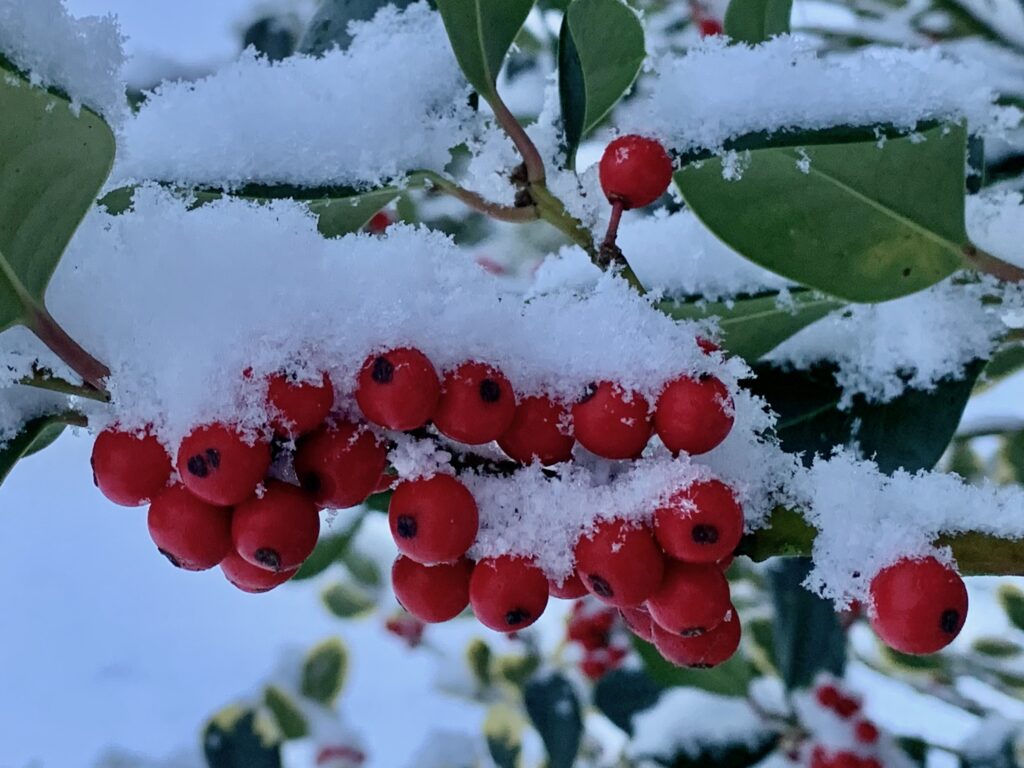
4 – Create a quiet contemplation zone in your Forest Bathing Garden
Add a soothing seating area to immerse yourself among the planting and relax the body as well as the mind.
A lounger is perfect for directing your gaze up towards the tree canopy, so you can enjoy the dance between shadow and light. In Japan, this dappled sunlight is known as komorebi (pronounced koh-mo-reh-bee) and is made up of the kanji characters for tree (木), shine through (漏れ), and sun (日).
Canopy gazing can also inspire a sense of awe and wonder, and help gain perspective on your own life. The colour green has been linked to enhanced creativity so you might find you do much of your best problem-solving here. Another great Japanese word – wabi-sabi (侘寂) – essentially describes the concept that beauty lies in the imperfections of nature. The acceptance of this when applied to our own shortcomings can lead to deep peace and satisfaction.

5 – Take inspiration from Japan
Give a nod to Japan where Forest Bathing is primarily practised by using the following plants:
- Pachysandra terminalis Japanese spurge
- Hakonechloa macra Japanese forest grass
- Kirengeshoma palmata Yellow wax bells
- Hosta sieboldii Small-leaved plantain lily
For trees and shrubs, consider using:
- Betula nigra Black birch
- Acer griseum Paperbark maple
- Prunus serrula Birch bark cherry
- Hydrangea serrata Mountain hydrangea
So there you have it. Five easy ways to add more Forest Bathing opportunities to your own garden. Happily, you can adapt much of this to houseplants too. Here is the full planting list that was used in the RHS Hampton Court Palace show, in case you’re interested. The important thing is not to stress about doing loads at once, and if you have a small space then only making a handful of small changes makes complete sense. Also, check with local friends and neighbours, perhaps you could get hold of cuttings rather than buy new, to save some pennies.
It’s not always easy to clear one’s own mind, which is why a guide often facilities group Forest Bathing sessions. It’s unlikely you’ll have a guide in your own garden, so be kind to yourself, and start with just 10 minutes, building up to 2 hours if you can.
Would you like to take it further and try guided Forest Bathing in Hampshire?
 I’m a qualified Forest Bathing guide with over 3 years of experience leading groups on walks around Hampshire (Winchester, Basingstoke, Salisbury, Newbury, Southampton, Romsey, Eastleigh and more…).
I’m a qualified Forest Bathing guide with over 3 years of experience leading groups on walks around Hampshire (Winchester, Basingstoke, Salisbury, Newbury, Southampton, Romsey, Eastleigh and more…).
Get in touch if you’d like to try out a guided walk so you can reap the plentiful rewards of mindfulness in nature while completely free from all responsibilities (no dogs, internet browsing or chit-chat allowed!).
